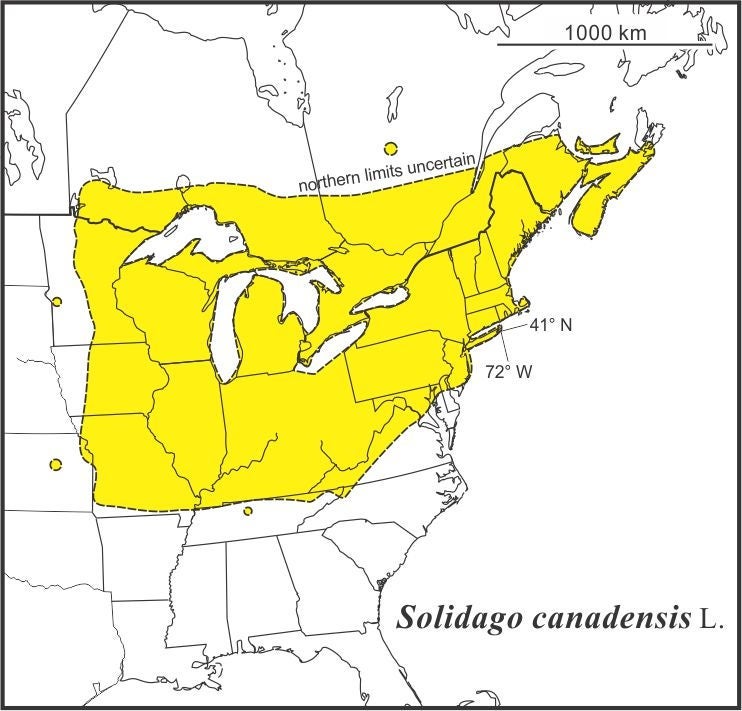Canada Goldenrod
Solidago canadensis L. as treated here is restricted to just two races native to the northeastern quarter of the U.S. and adjacent Canada. This follows Semple & Cook (2006 FNA). The species is distinguished by having upper stem leaves that are narrowly lanceolate, sparsely hairy on the veins and serrate on the margins. In the Maritimes, it can be confused with narrow-leaved forms of S. lepida. On the western and southern margins, var. hargeri can be confused for S. altissima; both have hairy lower stems. The species in the restricted sense includes only diploids (2n=18; Semple and Chmielewski 2022).
The range is not fully resolved. The literature and data on the internet often do not make it clear which races of S. canadensis in the very broad sense are included in a dot distribution. A final distribution map can only be completed after examining a very large numbers of collections separated into S. altissima, S. canadensis (both varieties), and S. lepida. The map presented here is odd in having the westward extension in Missouri; these are var. hargeri collections, which may reach further west than the map indicates in Iowa and Minnesota. Most if not all of the more southern collections are var. hargeri. Plants identified as S. canadensis var. canadensis from northern Ontario, Québec, and Newfoundland have all recently been determined to belong in S. bartramiana (synonym: S. brendae Semple; Semple 2023).
The cytogeography of S. canadensis was presented by Semple and Chmielewski (2022) with both varieties including only diploids. The late J.K. Morton sampled a large number of plants over much of the range (Morton et al. 2022). Many chromosome counts of 2n=36 and 2n=54 have been published under the name S. canadensis, but vouchers for all of these have been examined and were assigned to other species in Solidago ser. Canadenses: S. elongata, S. fallax, and S. lepida.

Two varieties are recognized in FNA (Semple & Cook 2006 FNA).
Statistical support for recognizing these varieties was recently presented in Semple et al. (2013) and Semple et al. (2015).
Semple, J.C. 2013. A new species of Triplinerviae goldenrod in eastern Canada (Asteraceae: Astereae): Solidago brendiae. Phytoneuron 2013-57: 1–9.
Semple, J.C., H. Faheemuddin, Y.A. Chong, M.K. Sorour, J.A. Hood, I. Khamis, Y. Ma, and K. Kornobis. 2013. A multivariate morphometric study of the Solidago canadensis / S. lepida complex of Solidago subsect. Triplinerviae. I. Northeastern taxa (Asteraceae: Astereae). Phytoneuron 2013-58: 1–20.
Semple, J.C., H. Rahman, H., S. Sbovski, M.K. Sorour, K. Kornobis, R. Lopez Laphitz, and L. Tong. 2015. A multivariate morphometric study of the Solidago altissima complex and S. canadensis (Asteraceae: Astereae). Phytoneuron 2015-10. 1–31.
Morton, J.K., J. Venn and J.C. Semple. 2022. Chromosome number determinations in Solidago brendae, S. canadensis, S. fallax, and S. lepida (Asteraceae: Astereae). Rhodora 123: 345–352.
Semple, J.C. and J.G. Chmielewski. 2022. Cytogeography of Solidago ser. Canadenses (Asteraceae: Astereae): S. brendae, S. canadensis, S. elongata, S. fallax, S. lepida, S. rupestris, S. shortii, and S. turneri. Phytoneuron 2022-57. 1-17.
Semple, J.C. 2023. On Solidago bartramiana, S. brendae, and S. canadensis (Asteraceae: Astereae). Phytoneuron 2023-29: 1–9.
Last revised 14 April 2025 by J.C. Semple
© 2025 J.C. Semple, including all photographs unless otherwise indicated